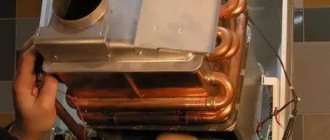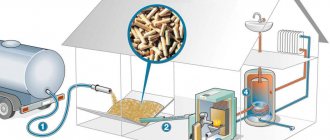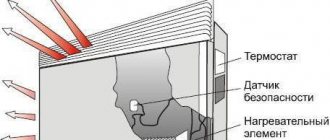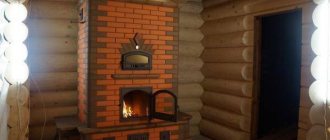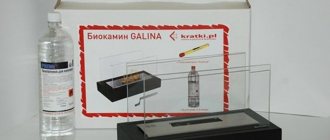Heating private houses with gas is a common occurrence these days, and this is not surprising: it is cheaper than heating with electricity. Many country and cottage settlements have gas mains, and if there is no main line, and its construction is not expected, then autonomous gas tanks are at your service.
A gas convector (catalytic gas heater) has the following operating principle: the air flow passing through the device is heated by gas combustion products (combustion products must be removed from the room). Convectors operate either on natural gas (from main gas pipelines) or on liquefied gas (propane-butane in cylinders or gas holders).
Convectors are used for heating any premises, both residential and utility. That is why when choosing a convector it is important to understand for what purpose it is being purchased. According to the type of installation, gas convectors can be wall-mounted or floor-mounted; below we will consider devices with both mounting options. There are not many manufacturers of this equipment, so some companies will be represented in the ranking more than once.
Editor's Choice
1.Hosseven HHS-9V 9 kW (average cost ≈ 33,000 rubles)
Hosseven HHS-9V 9 kW.
Photo: market.yandex The first in the top three is the floor convector HHS-9V from the Turkish company Hosseven. It has a high heating power of 9 kW, which allows it to effectively heat the air in spacious rooms. This is probably the most productive unit in this price category. It works both on liquefied gas from a cylinder or gas holder, and natural gas from the main line. For greater efficiency, the device is equipped with a fan and an automatic temperature maintenance function.
Main characteristics:
| Heating power | 9 kW |
| Combustion chamber type | closed |
| Heat exchanger material | steel |
| Additional functions | thermostat, fan, piezo ignition |
| Height | 640 mm |
| Width | 785 mm |
| Depth | 260 mm |
| Weight | 22.5 kg |
High heating power, presence of a fan
Noisy fan operation noted
show more
Karma BETA 5 Mechanic 4.7 kW (average cost ≈ 35,000 rubles)
Karma BETA 5 Mechanic 4.7 kW.
Photo: market.yandex Wall-mounted convector with very high declared performance from the Czech company Karma. The manufacturer talks about the possibility of heating a room of 100 square meters. m. with a power of 4.7 kW. However, no real tests could be found to support this claim. However, there is a very high efficiency of this model - about 92%. The combustion chamber is closed, ignition is piezocrystalline. It is possible to automatically maintain the temperature in the range from 13 °C to 38 °C. The heater operates on both natural gas and liquefied gas.
Main characteristics:
| Heating power | 4.7 kW |
| Combustion chamber type | closed |
| Heat exchanger material | steel |
| Control | mechanical |
| Gas type | natural gas, liquefied gas |
| Height | 600 mm |
| Width | 808 mm |
| Depth | 215 mm |
| Weight | 30 kg |
| Additional functions | piezo-crystal ignition, thermostat |
Declared high performance, the manufacturer emphasizes the use of high-class components in the device
No fan
show more
Hosseven HP-8 6.2 kW (average cost ≈ 41,000 rubles)
Hosseven HP-8 6.2 kW.
Photo: market.yandex The “designer” convector with wall mounting closes the top three. The power is very high - 6.2 kW, which is suitable for almost all residential premises, and the attractive appearance will help to fit the device into the design of the room. The combustion chamber is closed, the heater is also equipped with a thermostat and automatically maintains the room temperature in the range from 13 °C to 35 °C.
Main characteristics:
| Heating power | 6.2 kW |
| Combustion chamber type | closed |
| Heat exchanger material | steel |
| Height | 505 mm |
| Width | 900 mm |
| Depth | 200 mm |
| Weight | 28.5 kg |
| Additional functions | thermostat |
Appearance, high heating power
High price, no fan
show more
FEG Konvektor GF 35 P
Equipped with a heat exchanger, which is made from special high-strength steel, which is pre-heat treated. This element is manufactured using a unique patented technology, which ensures instant heat transfer to the environment. The device will not overheat or shut down even under the most severe operating conditions.
It runs on natural gas and is almost silent - no clicks or crackles were detected. If necessary, the device can be converted to propane or butane in cylinders. The design is characterized by increased power, but the external design is a bit disappointing - many consumers find the convector unsightly.
Advantages:
- Capable of running on propane and butane from cylinders;
- Operates absolutely silently;
- Adapted to harsh Russian working conditions.
Flaws:
- Not very stylish case design.
What other gas convectors are worth paying attention to?
Alpine Air NGS-50F 4.9 kW (average cost ≈ 31,000 rubles)
Alpine Air NGS-50F 4.9 kW.
Photo: market.yandex Wall-mounted convector of the Turkish manufacturer Alpine Air NGS-50 with a stated power of 4.9 kW. It is designed to operate on both liquefied and natural gas. The combustion chamber is internal, the heat exchanger is made of cast iron, which has a positive effect on maintaining temperature. The device is equipped with a continuously adjustable thermostat. The ignition is electric, but no connection to the mains is required - you need an AA battery. How convenient it is is up to you to decide. Electronic control. The model comes with a fan to enhance convection, but if you don't need one, consider the Alpine Air NGS-50.
Main characteristics:
| Heating power | 4.9 kW |
| Combustion chamber type | closed |
| Control | electronic |
| Gas type | natural gas, liquefied gas |
| Heat exchanger material | cast iron |
| Additional functions | thermostat, fan |
| Height | 630 mm |
| Width | 605 mm |
| Depth | 250 mm |
| Weight | 30 kg |
Cast iron heat exchanger, fan included
Electric ignition from a battery, not from the mains
show more
Alpine Air NGS-30F 3 kW (average cost ≈ 24,000 rubles)
Alpine Air NGS-30F 3 kW.
Photo: market.yandex Compact but quite powerful Alpine Air NGS-30F 3 kW convector with fan. The device can be connected both to the mains and to autonomous gas sources, and the fan will distribute heat more efficiently. Electric ignition is battery powered, which in some cases can be very inconvenient. Electronic control will be a definite plus for some users. There is also a fanless option: the Alpine Air NGS-30 model.
Main characteristics:
| Heating power | 3 kW |
| Combustion chamber type | closed |
| Control | electronic |
| Gas type | natural gas, liquefied gas |
| Heat exchanger material | cast iron |
| Additional functions | thermostat, fan |
| Height | 630 mm |
| Width | 455 mm |
| Depth | 250 mm |
| Weight | 23.5 kg |
Relatively small size, high power for small dimensions, presence of a fan, cast iron heat exchanger
Users note inconvenient controls, electric ignition from a battery
show more
Hosseven HDU-3V Fan 2.7 kW (average cost ≈ 25,000 rubles)
Hosseven HDU-3V Fan 2.7 kW.
Photo: market.yandex Convector for wall installation with an internal combustion chamber. Works on both natural and liquefied gas. Electronic control will be attractive for some users, and the stated range of automatically maintained temperatures is from 13 ° C to 35 ° C. The thermostat has seven adjustment levels. An undoubted advantage is that the device has a built-in fan for more active injection of cold air and distribution of heated air.
Main characteristics:
| Heating power | 2.7 kW |
| Combustion chamber type | closed |
| Control | electronic |
| Gas type | natural gas, liquefied gas |
| Heat exchanger material | steel |
| Height | 635 mm |
| Width | 470 mm |
| Depth | 270 mm |
| Weight | 13.4 kg |
| Main gas consumption | 0.28 m³/h |
| Additional functions | piezo ignition, fan, thermostat |
| Installation method | wall |
Possibility of operation on both liquefied and natural gas, relatively small size, presence of a fan
Users note the fan is noisy and the assembly is not very neat
show more
Karma GAMAT WR 20 2 kW (average cost ≈ 29,000 rubles)
Karma GAMAT WR 20 2 kW.
Photo: market.yandex Another compact wall convector Karma GAMAT WR 20 2 kW. A distinctive feature is the vertical design, which is suitable in cases where there is little space in the room. The device has the function of automatically maintaining the temperature from 13 °C to 35 °C.
Main characteristics:
| Heating power | 2 kW |
| Gas type | natural gas, liquefied gas |
| Combustion chamber type | closed |
| Control | mechanical |
| Heat exchanger material | steel |
| Height | 590 mm |
| Width | 316 mm |
| Depth | 150 mm |
| Weight | 16 kg |
| Additional functions | piezo ignition, autonomous temperature maintenance |
Small size, relatively light weight, good power with small dimensions
No fan
show more
FEG Konvektor GF30P 3.3 kW (average cost ≈ 37,000 rubles)
FEG Konvektor GF30P 3.3 kW.
Photo: market.yandex The device from the Hungarian manufacturer FEG Konvektor GF30P has a power of 3.3 kW and is designed for wall mounting. The combustion chamber is closed and made of cast iron. The device can automatically maintain the temperature in the range from 13 °C to 38 °C. The vertical design is suitable for small spaces.
Main characteristics:
| Heating power | 3.3 kW |
| Combustion chamber type | open |
| Heat exchanger material | cast iron |
| Height | 650 mm |
| Width | 500 mm |
| Depth | 325 mm |
| Weight | 34 kg |
| Additional functions | thermostat |
Cast iron heat exchanger, low operating noise
High price, no fan
show more
Gorenje MORA 6150.1022 2.5 kW (average cost ≈ 18,000 rubles)
Gorenje MORA 6150.1022 2.5 kW.
Photo: market.yandex An inexpensive and functional unit from the Czech company Gorenje. If you don’t need anything extra and don’t want to overpay, then this is your choice. The device is equipped with a thermostat (from 10 °C to 32 °C), can operate on both natural and liquefied gas, and most importantly, its dimensions allow it to be installed under a windowsill.
Main characteristics:
| Heating power | 2.5 kW |
| Combustion chamber type | closed |
| Heat exchanger material | steel |
| Installation method | wall |
| Height | 376 mm |
| Width | 552 mm |
| Depth | 206 mm |
| Heat exchanger | steel |
| Additional functions | start button, piezo ignition, thermostat |
| Weight | 12.8 kg |
Low price, dimensions allow the heater to be installed under a windowsill, light weight
No fan
ATON Vektor 2.2 kW (AOGC) (average cost ≈ 13,000 rubles)
ATON Vektor 2.2 kW (AOGC).
Photo: market.yandex Probably the most inexpensive option on today's market is a convector from the Ukrainian company ATON. The set of functions is standard; the device operates both from the mains and from the cylinder. Particularly pleasing is the presence of a thermostat with automatic maintenance of the set temperature. The low price is very attractive, but it should be remembered that this brand is not widespread in our country, so consumers do not have much experience in using it.
Main characteristics:
| Heating power | 2.2 kW |
| Combustion chamber type | closed |
| Heat exchanger material | steel |
| Gas type | natural gas, liquefied gas |
| Installation method | wall |
| Height | 590 mm |
| Width | 459 mm |
| Depth | 249 mm |
| Weight | 18.5 kg |
| Additional functions | thermostat |
Low price, light weight
No fan, unknown brand
Termotechnik AKOG-4
This device is ideal for a garage or country house.
The design is distinguished by the most accurate factory settings and compact overall dimensions. It is very easy to install, and it practically does not require any additional wiring. Such a convector is often installed even in industrial or industrial premises, the area of which does not exceed 40 square meters. m. The heater is absolutely independent of water and gas supply, since, if necessary, it can be connected to an ordinary gas cylinder - this is quite convenient, because centralized gas is not found everywhere. Combustion products will not penetrate into the room, which makes the device absolutely safe. Maintains the set temperature independently. The device's gas consumption is low, and the convector itself can last for quite a long time.
Advantages:
- It is a completely autonomous heating device;
- Lightweight and very compact device;
- Low fuel consumption;
- Operational safety.
Flaws:
- Some users feel that the control buttons are not very convenient;
- The convector is sensitive to changes in gas pressure.
How to choose a gas convector
Despite the fact that there are not very many manufacturers of gas convectors, and the range itself is not very large, making a choice can be difficult. Komsomolskaya Pravda asked an expert to help understand the intricacies of choosing a gas convector.
Advantages and disadvantages
First, let's look at the main advantages and disadvantages of gas convectors as a class of heating devices. As advantages, we can definitely name high autonomy in operation, relatively compact dimensions (unlike gas boilers), and low installation complexity. However, a convector can only heat one room, and you will need to buy a separate unit for each room. In addition, gas combustion products must be removed. This means that you will definitely need to make an output from each device either to the street or to the chimney. Let's assume that you've weighed the pros and cons and decided that this is the heating method your home needs. In this case, you need to keep a number of parameters in mind.
Mounting method
There are three options for convectors depending on the mounting method: floor-mounted, wall-mounted and mobile. There are many devices that can be installed and hung; mobile gas convectors are now very rare, since their use is difficult due to the need for constant removal of gas combustion products.
Type of fuel consumed
Gas convectors operate either from main (natural) gas or from a liquefied mixture of propane and butane. Liquefied gas is pumped into autonomous gas tanks and cylinders. Now most devices are adapted to work with these two types of gas, and the corresponding adapters are included with the devices. When installing a gas tank, you need to very carefully calculate the expected volume of gas consumption, and this should be done by a specialist. Cylinders are of little use for space heating due to their volume.
Combustion chamber type
Convectors are equipped with either open combustion chambers (chimney convectors) or closed combustion chambers (parapet convectors). As the name of the first type suggests, these devices require a chimney to operate. Oxygen is taken from the surrounding air. Such devices are more powerful, but their efficiency is slightly lower than that of parapet ones. Moreover, their installation is a very difficult undertaking. Convectors with closed combustion chambers have higher efficiency and are easier to install. Using a special pipe (coaxial), combustion products are discharged outside and oxygen is taken. We must, however, remember that every hole in the wall is a violation of thermal and sound insulation, no matter how well you seal it. The second type is almost ubiquitous in everyday life.
Heat exchanger material
The heat exchanger is a very important part in the convector. Steel, cast iron or copper are used to make it. Cast iron is more durable, heats up slowly, but most importantly, cools down slowly, therefore, it retains heat better, and usually the efficiency of devices with cast iron heat exchangers is higher. Copper has very good thermal conductivity and retains heat well, but is more expensive than steel or cast iron, so it is rare.
This is interesting
The best electric convectors
Power, temperature and heating area
Manufacturers almost always indicate heating power in kilowatts. Some even indicate the heating area. However, this information should not be taken at face value. If the manufacturer does not indicate the heating area, then it can be roughly calculated using the following example: one kilowatt per 10 square meters of room. Therefore, a 2.5 kW device can be designed for 25 sq. m., power 6 kW – for 60 sq. m. etc.
In reality, everything is much more complicated. Effective heating of a particular area, of course, depends on the power of the heater. But the properties of a particular room have no less, if not more, influence. In particular, its volume (manufacturers talk about area, not volume!), the quality of walls, joints and doors; the presence or absence of furniture and other items in the room. The temperature “overboard” plays a huge role. Obviously, at 0 °C the result will be one, and at -25 °C completely different.
A similar approach is valid for temperature conditions declared by the manufacturer. It is better that any device in your home always has a reserve of power and performance.
Principle of operation
Despite the apparent diversity of technological types of heating systems, their design and operating principle are almost identical. So, the design of any convector device contains the following components:
- gas burner with igniter , ensuring ignition and stable combustion of fuel;
- heat exchanger , which warms up the moving air and, as a rule, finned - to increase the working surface area;
- system for capturing and eliminating (emission into the external environment) combustion products;
- thermostat , which acts as a temperature valve - its main function is to maintain the set temperature;
- control automation , deactivating the system in the event of breakdowns and failures;
- housing , which serves as the basis for housing the main components, as well as a protective mechanism that prevents their interaction with the internal environment of the room.
The work of all the considered elements is possible only in close interaction with each other. In order to verify this, let us consider the dynamics of the processes occurring in the system during its operation.
Gas wall convectors have the following operating cycle:
- Gas coming from the main line or an attached cylinder to the burner is ignited by the ignition device and burns, heating the heat exchanger.
- A stream of cold air , which is usually taken from below, passes through a heat exchanger, where it is heated. Next, the air flows either directly to the exhaust window or into the fan chamber, which forces it into the room.
- Exhaust manifold , usually equipped with a forced exhaust electric motor, captures fuel combustion products and removes them outside through a coaxial (double-wall) pipe. Atmospheric air enters the same way, the oxygen of which is necessary to maintain combustion.
These are the general principles on which the operation of any gas convector is based. The nuances of the functioning of specific elements and their internal structure will be discussed in more detail in the next section.
Power and gas consumption
The choice of power depends on the area of the heated room. On average, 1 kW corresponds to 10 m2. The approval is suitable for standard buildings with a ceiling height of up to 3 meters.
The market offers household appliances from 2 to 12 kW. You need to choose a convector with a power reserve for drafts, ventilation, and poor insulation.
There is another formula for calculating power. The area of the room is multiplied by a correction factor (expressing operating conditions). Its meaning corresponds to:
- 0.1 - for bottled gas;
- 0.12 - when the convector serves as the main source of heating and is actively used during the day;
- 0.15 - the value is typical for poorly insulated or non-residential buildings.
Gas consumption depends on its type and number of devices. One kilowatt of power corresponds to a consumption of 0.11 m3/h of natural gas and 0.09 m3/h of liquefied gas.
To reduce the consumption of the convector, it is necessary to install a thermostat or additionally insulate the room. Correct installation of windows reduces fuel consumption by 20%.
Hyundai H-HV15-10-UI617
Photo: https://beru.ru
Hyundai H-HV15-10-UI617 is an inexpensive heater from a well-known manufacturer of household appliances. The device copes well with heating a room of 10 - 15 square meters. The product is safe to use and allows you to adjust the heating over a very wide range. Ideal for a dacha or private home where living is not carried out all year round. Considering the low cost of such products, with a large heating area, you can install 2 convectors. At the same time, the load on the electrical network will not be significant, because the power of each device is only 1 kW. Despite the presence of some shortcomings, the device is one of the highest quality in its price class.
Convector Hyundai H-HV15-10-UI617
Advantages:
- light weight
- nice price
- simple controls
Flaws:
- low power
- mechanical control
Hosseven HP-3
Photo: https://beru.ru
Do you need super-powerful heaters? Are you more interested in “low-voracious” ones? Then the Hosseven HP-3 is perfect. Very modest gas consumption (both main gas and bottled gas can be used), low power consumption, low weight - what more could you want? The effective heating area of such a unit is 50-60 square meters. meters, and it reaches the specified power a few minutes after the start of work. The walls of the heat exchanger are thin and elegant, but not at the expense of reliability. The design is excellent. You don’t have to worry about installation – everything is extremely simple.
Gas convector Hosseven HP-3 2.6 kW
Advantages:
- economical
- beautiful appearance
- the most reliable gas fittings
- low price
Flaws:
- relatively small heating area
Ballu BOGH-15
Photo: https://beru.ru
If we talk about models designed only for outdoor work, then the Ballu BOGH-15 is truly the best option. It is not only multifunctional, but also quite effective, and also meets all the necessary requirements in the field of safety and environmental friendliness. The device is turned on with the electric ignition button, which is located directly on the body. The height of the flame in a glass flask (of course, resistant to high temperatures) can reach about one and a half meters. The maximum heating radius of this heater is 3 meters, and the area is about 28 m2.
Gas outdoor heater Ballu BOGH-15
Advantages:
- stylish design
- simple controls
- safety
Flaws:
- high gas consumption
- high price
Installation recommendations
It is well known that the installation of a gas convector consuming main methane must be carried out by specialists from companies that have the appropriate permits. It is worth clarifying this somewhat generalized requirement: the issue is not installation, but connection to the gas supply network. This operation can indeed be performed by the above-mentioned workers in accordance with previously completed project documentation. This means that you can put the units in place with your own hands, but without connecting to the gas pipeline.
If you nevertheless decide to take bottled gas as an energy carrier, then the situation is simpler. Connecting propane heaters does not require any permits. However, it is strongly recommended to involve a specialist in this work, at least as a consultant. It will help you check the correctness and quality of the connections and carry out the first start-up of the unit.
Before installing a gas convector, you need to make a round hole of the appropriate diameter in the wall. Next, attach the device to the wall or floor according to the operating instructions. In this case, in some heater models, the external temperature sensor with a capillary tube must be moved from the transport position to the working position. After this, all that remains is to connect the fuel supply line to the inlet pipe on the device.
The best mobile gas heaters for home and garden
Bartolini Pullover K
The Bartolini Pullover K gas heater can be used for efficient heating of various types of premises: houses and apartments, cottages, outbuildings and garages. It can become the main or additional (or backup) heat source. The device is mobile - it moves easily on wheels. The heating element of the device is a catalytic panel. It is made of fiberglass, and platinum powder acts as a catalyst. Thanks to the use of this technology, there are no harmful emissions and no odor in the room during operation of the heater. The fuel for the device is liquefied propane-butane. The design of the housing is such that the gas cylinder (27 or 24.5 l) is placed inside and covered with a casing. The heater is equipped with safety elements:
- Burner flame level control sensor;
- Rollover protection (automatic shutdown when tilted);
- Air condition monitoring sensor (shutdown when carbon dioxide concentration is exceeded).
Additional features:
- Piezo ignition;
- Power regulator.
Main advantages:
- Reliability;
- Quiet operation;
- Manufacturer: Italy.
Minuses:
- Large dimensions.
Models in the line:
- Bartolini Pullover K Turbo Plus
- has 3 positions (turbo mode, hot air, cold air), heated area 45 - 50 sq. m.
Timberk TGN 4200 SM1
Timberk TGN 4200 SM1 ceramic gas heater is an inexpensive, mobile and universal device. Its mobility is ensured by its compact body and wheelbase for easy movement. The capabilities of the device allow it to be successfully used for heating premises of various types and purposes. The heater operates from a propane-butane cylinder (up to 12 liters, regular or 12.5 liters composite), which is easily placed inside a metal casing. For connection, the kit includes a reducer, gas hose and clamps. The room is heated by infrared radiation generated when ceramic plates are heated by a gas burner. Such material ensures complete combustion of fuel, and, therefore, the air does not contain combustion products. For safe operation, the model is equipped with gas control and a CO2 concentration monitoring sensor. Additionally, rollover protection is provided. Piezo ignition and power regulator are used as control elements.
Main advantages:
- Affordable price;
- Mobility;
- Versatility.
Minuses:
- Periodic ventilation of the room is necessary.
Ballu BIGH-3
Photo: https://beru.ru
This model is ideal for tourists or fishermen. The relatively light weight of 1.5 kg makes the device mobile and easy to transport. A power of 3 kW at maximum mode will allow you to heat an area of 30 m2. At the same time, fuel consumption is only 200 g per hour. Heating is produced by infrared radiation, which arises from gas heating of the ceramic panel. An important feature of this device is the rotating burner with a grid on legs. Thanks to this function, it can be placed in a horizontal position and the heater can be used as a stove for cooking, which makes the model an indispensable “comrade” when hiking and fishing. A nice bonus is that the kit already includes a 1.5 meter long hose and a reducer.
Gas stove Ballu BIGH-3
Advantages:
- light weight and compact size
- mobility
- budget price
- efficiency
Flaws:
- relatively short hose
When choosing a gas convector, as you already understand, you should pay attention to such important factors as:
- price
- safety
- heating area
- noise level
- installation specifics
- additional features
By following all the selection standards, you can easily choose the device you need. Enjoy the shopping!
#Top 10
Read us first - add the site to your favorite sources.
Add a comment
{"commentics_url":"\/\/express-novosti.ru\/comments\/","page_id":1331668,"enabled_country":false,"enabled_state":false,"state_id":0,"enabled_upload": false,"maximum_upload_amount":3,"maximum_upload_size":5,"maximum_upload_total":5,"securimage":true,"securimage_url":"\/\/express-novosti.ru\/comments\/3rdparty\/securimage\ /securimage_show.php?namespace=cmtx_1331668″,”lang_error_file_num”:”\u041c\u0430\u043a\u0441\u0438\u043c\u0443\u043c %d \u0444\u0430\u0439\u043b\u043e\ u0432\u043c\u043e\ u0436\u0435\u0442 \u0431\u044b\u0442\u044c \u0437\u0430\u0433\u0440\u0443\u0436\u0435\u043d\u043e.","lang_error_file_size":"\u041f\u043e \u0436\u0430\u043b\ u0443\u0439\u0441\u0442\u0430, \u0437\u0430\u0433\u0440\u0443\u0437\u0438\u0442\u0435 \u0444\u0430\u0439\u043b \u0440\u0430\ u0437\u043c\u0435\u0440\u043e \u043c \u043d\u0435 \u0431\u043e\u043b\u0435\u0435 %d MB.","lang_error_file_total":"\u041e\u0431\u0449\u0438\u0439 \u0440\u0430\u0437\u043 c\u0435\u0440\ u0432\u0441\u0435\u0445 \u0444\u0430\u0439\u043b\u043e\u0432 \u0434\u043e\u043b\u0436\u0435\u043d \u0431\u044b\u0442\u044c \ u043d\u0435\u0431\u043e\u043b\ u0435\u0435 %d MB.","lang_error_file_type":"\u041c\u043e\u0436\u043d\u043e \u0437\u0430\u0433\u0440\u0443\u0436\u0430\u0442\u044c \u0442\u0 43e\u043b\u044c ""lang_text_loading":" u0437\u043a\u0430 ..","lang_placeholder_state":"\u0420\u0435\u0433\u0438\u043e\u043d","lang_text_country_first":"\u0421\u043d\u0430\u0447\u0430\u043b\u0430 \u0432\u044b\u04 31\u0435 \u0440\u0438\u0442\u0435 \u0441\u0442\u0440\u0430\u043d\u0443″,”lang_button_submit”:”\u0414\u043e\u0431\u0430\u0432\u0438\u0442\u04 4c","lang_button_preview":" \u041f\u0440\u0435\u0434\u0432\u0430\u0440\u0438\u0442\u0435\u043b\u044c\u043d\u044b\u0439 \u043f\u0440\u043e\u0441\u043c\u 043e\u0442\u0440″,”lang_button_remove ":"\u0423\u0434\u0430\u043b\u0438\u0442\u044c","lang_button_processing":"\u041f\u043e\u0434\u043e\u0436\u0434\u0438\u0442\u0435..."}
Installation Rules
Once the convector has been purchased, it can be installed. Before you do this, you will need to have a certain set of tools:
- drill;
- spatula;
- pipe cutter;
- wrenches and adjustable wrench;
- screwdrivers;
- perforator;
- gas tap;
- special silicone;
- self-tapping screws;
- dowels
It is necessary to choose a place where it will be located. It is best to do this in accordance with GOST. According to it, installation must be carried out under a window. After this, you should prepare the room. That is, the surrounding space around the installation site must be covered. The installation is done according to this algorithm.
- It is necessary to determine the hole for the gas pipe to enter. It is necessary to leave a gap for the pipe and fitting.
- We make a through hole according to the size of the exhaust pipe using a hammer drill.
- We make holes for the fasteners on which the heater will be mounted, and hammer the dowels in there.
- We connect the device to the exhaust pipe and seal the joint with special silicone.
- We fix the heater to the wall using self-tapping screws.
- We seal all holes using foam to prevent cold air from entering the room.


